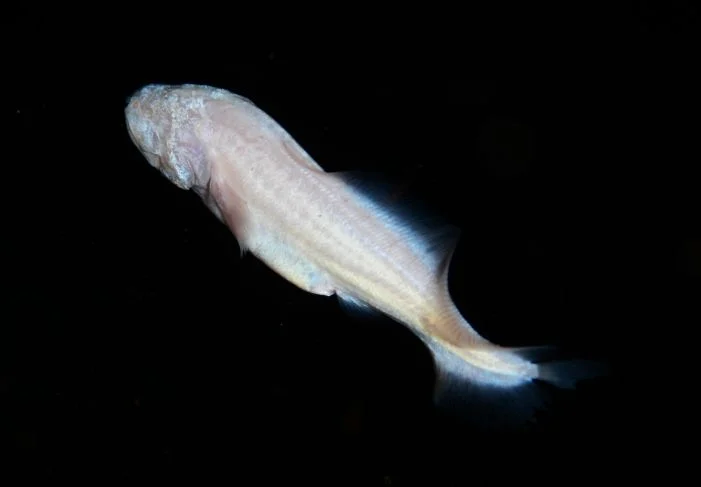Merida, Yucatan, (September 24, 2021).- The entrails of the Yucatecan slabs are home to species that do not always attract the attention of those who visit them. Such is the case of “La Dama Blanca”, the White Lady ( Typhliasina pearsei ), a peculiar fish endemic to the Yucatan peninsula whose main characteristic is its absence of eyeballs.
Like many other species, the White Lady is under constant threat due to various types of pollution that prevail in the cenotes that populate the peninsular geography, a situation that could endanger its ecosystem balance, warned the Master of Science, Alfredo Gallardo Torres.
Observed for the first time in the caves of Balankanché -from where it has disappeared for these same reasons- the ‘Dama Blanca’ is a freshwater fish that can only be found in the caverns and cenotes of the states of Quintana Roo and Yucatán.
They are small fish, less than 10 centimeters long and one of their main characteristics is that they are anophthalmic, that is, they do not have eyes, added the professor, who also serves as curator of the Regional Ichthyological Reference Collection of the Multidisciplinary Unit of Teaching and Research (UMDI) Sisal.
“As it lacks pigments, its color is white, that’s where it takes its name,” he said.
The White Lady is not necessarily found at great depths, there are variations. In Yucatán, for example, the first sightings of this species occurred in shallow areas, that is, in shallow waters.
(1).jpg)
“However, in Quintana Roo, where cave systems are different from those of Yucatán, they have been found at depths of up to 70 meters. Other more recent reports indicate that this fish has been sighted at even greater depths, ”he explained.
These organisms are blind because the habitats where they can be found lack light, which allows them to dispense with the eyes. They are supported by other senses such as the lateral line; or chemical and olfactory perceptions to detect their prey.
“Many of the organisms that the White Lady feeds on also share this characteristic”, explained the master Gallardo.
Regarding their diet, the academic commented that their diet is based on troglobian organisms -which have adapted to cave life- and crustaceans that usually inhabit these bodies of water.
Top predator
In the cave systems it inhabits, there is usually not much diversity of organisms and the White Lady is the top predator of its ecosystem under undisturbed conditions. Nobody eats this fish, at least in Yucatán.
“That does not mean that he does not have threats,” he clarified. “In the cave systems of Quintana Roo, for example, it has been seen that sometimes other species enter that are not caves or cenotes and could be predating them,” he added.
Regarding its reproduction, Alfredo Gallardo stated that it is a low-fecundity fish. Something curious, he mentioned, is that it is a species belonging to the group of viviparous brotulas, which give birth to their young; unlike most fish, which are oviparous.
As they are species that are not abundant in the ecosystem, there is not much information about them. Gallardo Torres attributed the above to the fact that they inhabit places that are not always easily accessible; or their populations decline due to pollution.
“Here we have a very serious problem with the cenotes that are used as garbage deposits; and we are talking about very sensitive organisms. So in some places where there was a record of their existence, they have disappeared due to these contamination processes, ” he lamented.
(1).jpg)
On the Red List of Threatened Species, the White Lady is listed as a near threatened. This category is assigned to it, he detailed, since some of the localities where its presence has been registered are within protected areas.
“But there is a lot of information that is unknown. We do not know if the populations have increased or decreased. Much of the information is ‘anecdotal’ from cave divers who report that they no longer see them as abundantly as before, ” he said.
Being a top predator, the White Lady acts as a controller of other organisms that are below its trophic level. Many of the crustaceans on which it feeds, in turn, feed on the guano of bats, which promotes a flow of energy in the ecosystem.
“There is much that we do not know about this species and if we do not establish actions to take care of the cenotes and limit the contamination of the water table, we could be missing out on things that we do not know,” concluded Master Gallardo.
Size: Less than 10 centimeters
Habitat: Cenotes and caverns of Yucatan
Characteristics: Freshwater fish, anophthalmic
Food: Troglobian and crustacean organisms
Reproduction: Oviparous; two to three young
Source: La jornada maya
TYT Newsroom


